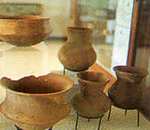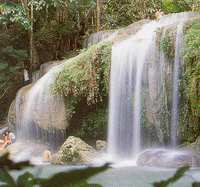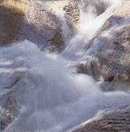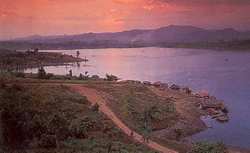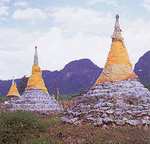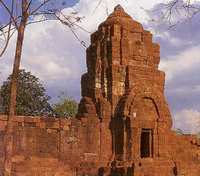
The more western Route 323 largely parallels the Kwai Noi River to the Khao Laem Dam, 153 kilo- metres from the provincial capital. Major attractions along, or near, Route 323, and within 250 kilometres of the provincial capital, include: Cultural Centre The centre, located at the Rajabhat Institute, some 14 kilometres beyond the provincial capital, houses a permanent exhibition of ancient and modern lifestyles. Phu Phra Cave 15 kilometres from town, this cave is where a legendary character from Thai literature is said to have studied magic.
Muang Sing Historical Park Well-sign posted from Route 323, and 43 kilometres from town, this ancient site is located on a steep bank of the Kwai Noi River where the waterway narrows and becomes fast flowing. The 800-year-old city ruins are of considerable archaeological interest, and the principal structure, the Khmer Prasat Muang Sing (Tower of the City of Lions) is believed to have been the westernmost outpost of the Angkor-centred Khmer empire. Skeletal remains dating back some 2.000 years have been unearthed and a wide range of artefacts, including temple carwings, religious statuary, implements and pottery shards indicate the once-thriwing city must have been inhabited from approximately the 12th to 14th centuries. Open daily from 7.30 am. - 5.30 pm. Admission is 40 Baht.
Ban Kao National Museum 8km from Prasat Muang Sing, and 35 kilometers from town, this also overlooks the Kwai Noi river. The museum was constructed beside a Neolithic burial site discovered by an Allied prisoner-of-war during the construction of the Death Railway. Some 4.000 years ago, Neolithic man lived, roamed and hunted beside the Kwai Rivers, sheltering beneath rock overhangs or in nearby caves. The Ban Khao Museum houses skeletal remains, pots, axe heads, jewellery maid from animal bones, and other artifacts dating from that era.
Sai Yok Noi Waterfall Also known as Khao Phang waterfall, 60 kilometres from town on Route 323, this is the first of several waterfalls. The roadside cascade is best visited between July and September when water is most plentiful, and is 2 kilometres northwest of Nam Tok Railway Station the terminus of the branch line originating in the provincial capital. and which crosses the world famous bridge.
The Lawa Cave 75 kilometres from tovn, the largest cave in the area has stalactites and stalagmites in several chambers. Visitors may take boats from the Kwai Noi River Pak Saeng Pier at Tambon Tha Sao (southwest of Nam Tok Railway Station and Sai Yok Noi Waterfall) to explorte this cave, and travel :afterwards upstream to the riverine Sai Yak Yai Waterfall, 104 kilometres from town. A canoe trip of two hours or more from a mountain pass to the stunning cave is also possible. Canoeist can book with Safarine Tour, which specializes in canoe trips. Sai Yok Yai Waterfall This flows directly into the Kwai Noi River, and is the most popular attraction in the 300-square-kilometre Sai Yok National Park. The park contains several interesting caves besides the Lawa. The Daowadueng Cave, which also entails a river trip for visits, is the most popular. South of the Sai Yok Yai Waterfall, another cascade, the Nam Chon Waterfall, flows directly into the river. Wildlife in Sai Yok's deciduous forests include small mammals such as bats, squirrels and deer, and numerous bird species, including wreathed hornbills and blue-winged pittas. Human presence at Sai Yok is known to date back to the Stone Age, and the Sai Yok Yai Waterfall has been repeatedly celebrated in Thai poetry and song. Bungalow accomodation, river rafts and camping facilities are available. Hin Dat Hot Springs 130 kilometres from town, these occupy a hollow some 3 kilometres northeast of Route 323.
Pha Tat Waterfall The three-tiered cascade, 140 kilometres from town, is some 12 kilometres northeast of Route 323, along the same track.
Pilok Mine 60 kilometres west of Amphoe Thong Pha Phum on Route 3272, there was much mining of wolfram and tin in the Tanaosri Mountain range marking the Thai-Burmese border. A temperate fruit decorative winter plant orchard, Pilok Hill, 32 kilometres from town, can be visited en route.
Khao Laem Dam 153 kilometres from town, this imposing structure has a 9-hole golf course, tennis courts, guest house and motel accommodation, and a scenic reservoir upon which several private complexes offer opportunities for boat rides, swimming and fishing. Areas beyond Khao Laem Dam meriting visits either edge the extensive reservoir or nestle against the Thai-Burmese border. Sangkhla Buri This petite settlement, some 225 kilometres from Kanchanaburi, edges the northernmost extremities of Khao Laem Dam. The scenic 75-kilometre route from Khao Laem largely parallels the reservoir, passes several raft complexes, botanical gardens and roadside cascades, and vistas of partly submerged trees crowding the reservoir banks.
This even smaller settlement 241 kilometres from Kanchanaburi, marks the rugged Thai-Burmese border, and is the site of a small but thriving border market. Visitors are allowed to enter the neighbouring Burme settlement between 6.00 a.m. and 6.00 p.m. (when the border is closed). The three miniature pagodas are memorials to what was the traditional invasion route favoured by Burmese soldiers during the Ayutthaya period (1350-1767). Wat Wang Wiwekaram This extensive temple on the southern outskirts of Sangkhla Buri edges the Khao Laem Dam. The complex is constructed in an unusual pastiche of Thai, Indian and Burmese Buddhist architectural styles, and the abbot is highly revered among local people, including tribal folk and Burmese. Sangkhla Buri Forest Tours Certain Kanchanaburi travel agents offer one-day elephant trekking and rafting tours in the immediate vicinity of Sangkhla Buri. A ride can be incorporated into a longer trek featuring mountainbiking and rafting. Visitors are advised to contact eirher local travel agent or the TAT's Kanchanaburi office for current details since the tours are not always conducted on a daily basis. Thungyai Naresuan Wildlife Sanctuary Northeast of Sangkhla Buri, this sanctuary occupies a terrain of forested mountains and high plains, and hosts numerous protected wildlife species including tigers, bears, elephants and deer. The area iis rugged, remote, and demands 4-wheel-drive vehocles for exploration. Special permission from the Royal Forest Department is needed for admission. Visitors interested in entering the area are required to contact the Royal Forest Department in Kanchanaburi, Tel: (66 34) 511-566.
|
|||||||||||||||||||||||
© 2004 - 2013 www.thailand-huahin.com
| Hua Hin | Baan Sunanta Hua Hin | Hua Hin Resort | Hua Hin Apartment | Hua Hin Pictures | Taxi Hua Hin | Hua Hin Hotels Hua Hin Resorts |
| Hua Hin Accommodation | Rent Hua Hin | Hua Hin Deals | Hua Hin Property | Hua Hin Expat | Hua Hin |
| Hua Hin Apartments | Hua Hin Condos | Hua Hin Villas | Hua Hin Houses | Hua Hin Vacations | Hua Hin Beach |
| Bangkok Hotels | Thailand Hotels | Thailand Travel | Thailand Pictures |
| Hua Hin Accommodation | Rent Hua Hin | Hua Hin Deals | Hua Hin Property | Hua Hin Expat | Hua Hin |
| Hua Hin Apartments | Hua Hin Condos | Hua Hin Villas | Hua Hin Houses | Hua Hin Vacations | Hua Hin Beach |
| Bangkok Hotels | Thailand Hotels | Thailand Travel | Thailand Pictures |

